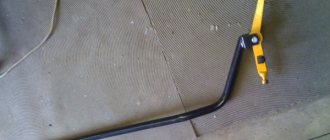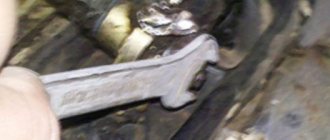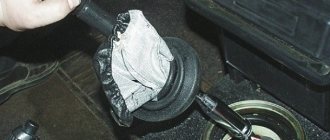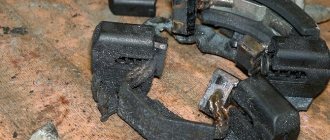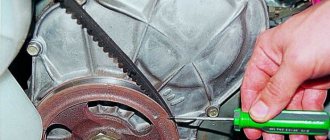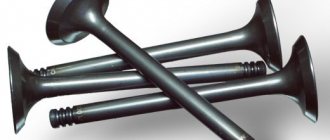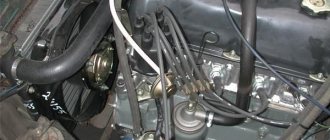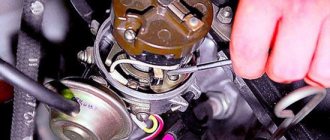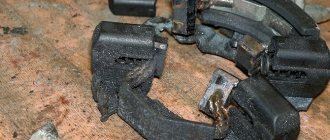Structurally, the seventh model in the VAZ line is recognized as one of the simplest and most accessible for independent maintenance and repair. However, the “seven” also has complex components, which not every driver can repair with his own hands. One of these components is rightfully considered the gearbox.
- Gearbox design
Table: gear ratio ratios on VAZ 2105 and VAZ 2107
- Main technical characteristics of the VAZ 2107 box
Video: operating principle of a VAZ manual transmission
- What kind of gearbox can be put on the “seven”
- Why don't the gears turn on or turn on randomly?
- Removing the box
Video: instructions for dismantling work
- Video: instructions for disassembling the mechanical box
- Video: how to visually determine wear of bearings on shafts
- Input shaft oil seal
Photo gallery: replacement procedure
- Photo gallery: work procedure
- Video: a unique video on removing gear from fifth gear
- How to check the oil level in the gearbox
Photo gallery: do-it-yourself oil change in a box
- Self-adjustment of the scenes
Video: instructions for adjusting work
Gearbox VAZ 2107: what is it
What is a gearbox in a car design? The abbreviation “KPP” stands for “gearbox”. This is the name of the unit, which is designed to change the frequency of torque.
It is curious that the first gearboxes were invented not for cars, but for machine tools to change the speed of rotation of the equipment.
The purpose of the gearbox is to perform the function of converting the amount of torque that comes from the engine and transferring this energy to the transmission. This is the only way to change speeds in increasing increments.
The gearbox on the VAZ 2107 appeared in 1982 along with a new model in the AvtoVAZ line - the “seven”. Structurally and practically, this gearbox is still considered the most advanced unit among classic manual gearboxes.
For the first time, five-speed gearboxes began to be installed on the VAZ 2107
Gearbox device
The VAZ 2107 is equipped with a five-speed gearbox, that is, changes in the torque frequency are possible in five positions. At the same time, five gears allow you to drive forward at different speeds, and the sixth is considered reverse and is activated at the moment when the driver needs to reverse.
The shift pattern for these gears is no different from the classic four-speed one that was installed on earlier VAZ models. The driver just needs to depress the clutch pedal and move the gearshift lever to the desired position.
The external design of the box does not allow us to understand the internal design of the elements
It should be noted that, structurally, the box on the “seven” is a rather complex device, so the diagnosis and repair of this device is usually trusted only to professionals. However, the “seven” gearbox adopted the main parameters from the “five” one, since AvtoVAZ designers took the VAZ 2105 as the basis for the new gearbox.
Table: gear ratio ratios for VAZ 2105 and VAZ 2107
| Model | VAZ 2105 | VAZ 2107 |
| Main couple | 4.3 | 4.1 / 3.9 |
| 1st gear | 3.667 | 3.667 |
| 2nd | 2.100 | 2.100 |
| 3rd | 1.361 | 1.361 |
| 4th | 1.000 | 1.000 |
| 5th | 0.801 | 0.820 |
| Rear | 3.530 | 3.530 |
Speaking about the general design of the gearbox on the VAZ 2107, it should be borne in mind that externally it has the shape of a closed housing. In this case, only three of its sides are completely closed (special durable covers are used for this), and the fourth side of the box “grows” into the gear shift knob. All lids fit tightly to the box, their joints are sealed.
The checkpoint consists of up to 40 elements
The main elements of gear shifting are “hidden” in the gearbox housing:
- input shaft (four drive gears and synchronizers are installed on it);
- secondary shaft (ten gears are mounted on its surface at once);
- intermediate shaft.
Let's consider each element separately in order to understand at least the general principle of the design and operation of the gearbox.
Primary shaft
Just by the name you can understand that the input shaft is the fundamental element of the box. Structurally, the shaft is one piece with four gears and rotates together with them on a bearing. The rotating bearing itself is fixed in the lower part of the box and is sealed with an oil seal to ensure reliable connection.
All gears located on the shaft have different dimensions for ease of connection
More information about the VAZ 2107 input shaft: https://bumper.guru/klassicheskie-modeli-vaz/kpp/pervichnyiy-val-kpp-vaz-2107.html
Secondary shaft
We can say that the secondary shaft is, as it were, a logical continuation of the primary housing in space. It contains gears for 1st, 2nd and 3rd gears (that is, all odd numbers). All ten gears on this shaft have different dimensions, and therefore ensure the conversion of torque.
The secondary shaft, like the primary shaft, rotates on bearings.
The secondary shaft can be called the main element of the gearbox due to the increased loads that fall on its gears
Intermediate shaft
The main task of this element is to serve as a kind of “layer” between the primary and secondary shafts. It also has gears that are integral with the shaft, through which torque is transmitted from one shaft to another.
The main task of this element is to interface the work of the primary and secondary shafts
Set of forks
Ease of gear shifting while driving is provided by a set of forks. They are driven by the shift lever. The forks press on one or another gear of a certain shaft, causing the mechanism to work.
The fork is used to change the gears of the car.
Of course, there is a special hole in the housing through which lubricant is poured into the gearbox. This hole is located on the left side of the gear shift knob and is closed with a plug. The volume of the gearbox on a VAZ 2107 is approximately 1.6 liters of oil.
Five-speed manual transmission
The seventh model Zhiguli has a five-speed gearbox with five forward speeds and one reverse.
It is made of duralumin and has similar covers on the front and back. The clutch cover is attached to the front of the box using studs. A steel cover is installed on the bottom of the device. There are sealing gaskets between the box body and each lid.
The front cover is connected to the clutch housing using a press fit. There is a hole in it for the input shaft to exit and install the cuff.
Inside the box, shafts with gears, synchronizers and gear shifting devices are installed in a certain order. There is an oil filler hole on the right, and a drain hole with a magnetic plug on the bottom.
At the bottom left of the cover comes the speedometer cable, which is driven by the secondary shaft using a gear.
The gear shift lever is on top. Consists of a gear selection device, rods and a locking mechanism. A handle is attached to the lever on top. This entire structure is attached to the lid using three studs.
Type of gearbox:
- Clutch cover.
- Breather.
- Box body.
- Rear cover.
- Gear shift lever.
- Lever housing.
- Coupling flange.
- Screw.
- Speedometer drive.
- Tray cover.
- Hole for filling.
Exploded parts:
- Fork for engaging 3rd and 4th gears.
- Fork for engaging 1st and 2nd gears.
- Fork fastener.
- Engraving washer.
- Fork rod for engaging 1st and 2nd gears.
- Rusk.
- Fork rod for engaging 3rd and 4th gears.
- Gear shift lever.
- Fork rod for engaging 5th gear and reverse.
- Rusk.
- Rusk.
- 5th gear and reverse detent spring.
- Retainer cover with gasket.
- Retainer springs.
- Ball retainers.
- Fork for engaging 5th gear and reverse.
- Sleeve.
Moving parts of the gearbox:
- Intermediate shaft.
- Front intermediate shaft bearing.
- Rear main shaft bearing.
- Input shaft with 4th gear gear.
- Synchronizer clutch for 3rd and 4th gears.
- Synchronizer clutch hub.
- Synchronizer clutch for 1st and 2nd gears.
- Synchronizer clutch hub.
- Front secondary shaft bearing.
- Secondary shaft.
- Intermediate bearing of the secondary shaft.
- Rear secondary shaft bearing.
- 5th gear synchronizer clutch.
- Synchronizer clutch hub.
- Reverse gear.
- Gear with 5th gear synchronizer.
- Speedometer drive gear.
- Gear block for 5th gear and reverse gear.
- Gear block bearing.
- Reverse intermediate gear.
- Reverse idler gear axis.
- Rear intermediate shaft bearing.
- Gear with 1st gear synchronizer.
- Gear with 2nd gear synchronizer.
- Gear with 3rd gear synchronizer.
Main technical characteristics of the VAZ 2107 box
The “seven” gearbox works in conjunction with the clutch. The VAZ 2107 is equipped with a single-plate dry clutch, which has only one (central) pressure spring. This is quite enough for convenient control of vehicle speeds.
The gearbox is only mechanical, three-code, five-speed. The VAZ 2107 has synchronizers for each forward gear.
The device weighs quite a lot - 26.9 kg without oil.
Video: operating principle of a VAZ manual transmission
What kind of gearbox can be put on the “seven”
The VAZ 2107 will willingly work with both a four-speed and a five-speed gearbox, so only the driver decides which model to choose.
If we talk about domestic “VAZ” gearboxes, then initially the “seven” was equipped with a four-speed unit, so you can always buy and install this particular unit. The main advantage of such a box is its increased performance - the driver drives 200 - 300 thousand kilometers without ever investing in repairing the device. In addition, the four-speed gearbox is more suitable for low-power 1.3-liter engines or for drivers who often transport heavy loads by car, since the gearbox is initially designed for high traction.
Five-speed gearboxes allow you to reach higher speeds. Younger drivers like this, since at the start and when overtaking you can squeeze maximum power out of the car. However, over time, such boxes began to be made from low-quality materials, so switching is not always clear.
Foreign gearboxes can also be installed on the VAZ 2107. Boxes from Fiat are most suitable, since it was this car that became the prototype of domestic models. Some car enthusiasts install boxes from older versions of BMW, but the installation procedure can take a lot of time, since the car’s original design does not provide for non-standard units.
When changing the factory gearbox, you should keep in mind that the new gearbox may not fit the dimensions and mounts to the VAZ
CHARACTERISTICS
The car was produced from 1982 to 2013. VAZ 2107 configurations include small volume and power engines, from 1.3 to 1.7 liters. The minimum number of horsepower is 64, the maximum is 135.
All variations without exception are equipped with a five-speed manual transmission. Acceleration time to 100 kilometers per hour varies from 13 to 17 seconds, depending on the internal combustion engine. Although the maximum permissible speed of a car is 180 kilometers per hour, even the engineers themselves do not recommend exceeding the mark of 140. The danger is due to the lowest rating according to automotive safety standards (poor engine location, fragile body materials, etc.), a high probability of skidding due to low weight - 1040 kilograms - and rear-wheel drive.
Even the average fuel consumption - 9-10 liters - cannot be called an advantage of the car, since much more serious analogues with 3 or even more liter units consume comparable amounts of gasoline. By the way, there are no diesel versions of the VAZ 2107.
VAZ 2107 gearbox malfunctions
The VAZ 2107 is rightfully considered a “workhorse”. But this model cannot last forever. Sooner or later, the car begins to act up. If any faults appear in the box, the owner needs to immediately take the necessary measures, since these defects directly affect the ability to operate the car.
Why don't the gears turn on or turn on randomly?
This is every driver's nightmare when the car does not obey his orders or performs actions in a random order. To prevent this from happening in reality, you should find out the source of these problems at the very first problems with turning on gears:
- Severe wear of the moving parts of the box (hinges, springs) - it is best to carry out a major overhaul of the gearbox.
- The blocking rings on the synchronizers have worn off - it is recommended to simply replace them with new ones.
- The synchronizer spring is broken - replacing it will help.
- The teeth on the gears are worn out - it is recommended to replace the gear.
If the lever stops “obeying” the driver, you need to immediately identify the cause of the malfunction
Why does it knock out a gear when it is turned on?
There are often cases when the driver cannot engage one or another gear. Accordingly, the motor experiences increased loads, which negatively affects driving. You need to figure out what exactly the problem is and take action:
- The clutch cannot disengage completely - it is necessary to adjust the clutch mechanisms.
- The hinge on the shift lever is jammed - clean the hinge joints.
- The lever itself is broken - you need to replace it with a new one.
- Deformation of the forks in the box (usually happens after accidents) - it is better to immediately replace the whole set without trying to straighten it.
It is difficult for the driver to control the car if at least one gear is knocked out immediately after switching on.
You can hear noise and crunching from the box
It is very unpleasant when loud sounds and heartbreaking crunches are heard while driving. It looks like the car is about to break in two. However, the reason for this is a malfunction in the gearbox:
- The bearings on the shafts are noisy - the broken parts need to be replaced.
- Severe wear on the teeth on the gears - replace them.
- There is not enough oil in the box - add fluid and find the leak to prevent further malfunctions.
- The shafts have begun to move along their axis - the bearings need to be replaced.
The shafts in the gearbox must always be joined at a certain angle and be well lubricated
Why is oil leaking from the box?
Full operation of the gearbox on a VAZ 2107 is impossible without good lubrication. About 1.6 liters of oil is poured into the box, which is usually completely changed only during a major overhaul. The oil itself cannot leak out anywhere, since the body is sealed as much as possible.
However, if a puddle accumulates under the car while parked, and the internal parts under the hood are heavily oiled, it is necessary to urgently look for the cause of the leak:
- The seals and gaskets are worn out - this is what causes the depressurization of the box; you need to immediately replace the rubber products and add oil.
- The crankcase fastenings have become loose - it is recommended to simply tighten all the nuts.
Excess liquid can cause short circuits in electrical appliances.
Note that some types of troubleshooting work are available to the average driver. However, it is better to entrust serious and large-scale procedures (for example, gearbox overhaul) to professionals.
Repair of VAZ 2107 gearbox
Repairing the box yourself is a task that only an experienced car owner, who is accustomed to servicing and repairing the car on his own, can handle.
Removing the box
The box can be repaired only after it is removed from the car, so you will have to drive the “seven” onto an overpass or inspection hole and get to work.
For work, it is better to prepare in advance:
- two screwdrivers with a thin flat blade;
- tweezers;
- a Phillips-blade screwdriver;
- socket wrench 10;
- socket wrench 19.
IMPORTANT! The box must be dismantled only after draining the oil.
The procedure for removing the gearbox is carried out according to the following regulations:
- After the car has been installed in the pit, you need to disconnect the wire from the negative terminal on the battery, and then drain the oil from the box.
- Remove the radio panel.
- Press the lever, insert a flat-head screwdriver into the hole in the locking sleeve of the box, and pull the sleeve out.
- Remove the rod from the lever.
- Take tweezers and remove the elastic rubber insert of the damper from the lever.
- Using two flat-head screwdrivers, open the petals of the damper insert and remove them from the lever.
- Remove the damper and all its bushings from the lever.
- Next, move the upholstery mat on the floor of the car.
- Take a Phillips screwdriver and remove the four screws on the box lid.
- Remove the box cover from the lever.
- Remove the exhaust pipe from the muffler.
- Disconnect the block with the clutch using a Phillips screwdriver.
- Remove the cable harness.
- Remove the cardan drive.
- Disconnect the flexible shaft from the speed device.
- Take a 10 mm socket wrench and unscrew the two bolts securing the side cover of the box.
- A strong, stable support must be installed under the box.
- Take a 19 mm socket wrench and unscrew the four bolted connections securing the crankcase to the cylinder block.
- Insert a flat-head screwdriver into the gap between the crankcase and the block and press both devices with it.
- The dismantling of the gearbox on the VAZ 2107 has been completed.
More information about removing the gearbox on a VAZ 2107: https://bumper.guru/klassicheskie-modeli-vaz/kpp/kak-snyat-korobku-na-vaz-2107.html
Video: instructions for dismantling work
How to disassemble a gearbox
The removed box must be installed on a level and clean place. To disassemble the device for parts, you will need the following tools:
- adhesive composition;
- impact screwdriver;
- three-jaw bearing puller (you may also need a vice);
- new seals;
- full set of gaskets;
- torque wrench.
It is important to follow the rules and order of work in order to correctly carry out the disassembly procedure
The procedure for disassembling the box is one of the most difficult procedures when working on a VAZ 2107. The design of the gearbox has many small parts; inattention to any of them can lead to disastrous results. Therefore, it is recommended to disassemble the box yourself and replace worn-out elements only if you have extensive practical experience in this area.
Video: instructions for disassembling the mechanical box
We change bearings
All three shafts in the gearbox rotate thanks to the bearings. However, experienced drivers know that it is the bearings that cause the main heap of problems, since during operation sooner or later they begin to leak, knock or wear out their service life.
Video: how to visually determine wear of bearings on shafts
The VAZ 2107 gearbox contains bearings of different sizes, but none of them provide for a repair and restoration procedure. Therefore, during repairs it will be necessary to knock the shafts out of the bearings and install new hinge devices.
Video: instructions for replacing the bearings of the primary and secondary shafts
Lever tuning
The gear lever is located on the “seven” somewhat poorly, some believe that it is too long, others stretch far, and a general remark when turning on the reverse gear is added to the main ones, that we hit our hand on the passenger’s knee.
Some select levers from foreign cars that are suitable in size and secure them. The second, and easiest, thing to do when upgrading the handle yourself is to simply make it shorter. To do this, the lever rod is sawed off to 5 - 7 cm in length and the thread is re-cut.
The most radical way of tuning is to move the lever closer to the driver and reduce its travel when changing gears. It looks, when brought to its logical conclusion, solidly.
Read more about this procedure on the website.
The above tuning of the lever makes the interior of your car unique, but do not forget about driving safety because the given examples have their pros and cons, and it’s up to you to decide whether to do them or not.
The role of oil seals in the operation of the gearbox, how to replace it
A seal is a dense rubber gasket, the main task of which is to seal the joints between different parts in the box. Accordingly, if the oil seal is severely worn, the sealing of the device is broken, and oil leaks may occur.
To prevent loss of lubricant and restore the tightness of the device, it will be necessary to change the oil seal. To do this, you will need simple tools that the driver always has at hand:
- nut heads;
- hammer;
- flat screwdriver;
- knife (they are most convenient for removing the old gasket);
- new oil seal;
- sealant.
Oil seals protect the box body, preventing oil leakage
Input shaft oil seal
This product is made of CSP and NBR composite, which ensures the longest possible service life. In working condition, the oil seal is completely immersed in transmission oil, due to which its elasticity is maintained for a long time.
The input shaft oil seal is designed to operate in a temperature range from -45 to +130 degrees Celsius. Weighs 0.020 kg and measures 28.0x47.0x8.0 mm
The input shaft seal of the VAZ 2107 gearbox is located in the clutch housing. Therefore, to replace it, you will need to dismantle the casing. And to do this, you need to drive the car onto an overpass or inspection hole.
Replacement of the input shaft gasket is carried out as follows:
- Remove the gearbox from the car (you can get the oil seal with the gearbox still in place, but the procedure will take a lot of time).
- Remove the fork and release bearing from the gearbox (this will require a hammer, puller and vice).
- Remove six nuts from the casing.
- Remove the casing itself (it has the shape of a bell).
- Access to the oil seal is now open: remove the old gasket with a knife, thoroughly clean the joint and install a new oil seal.
- Next, assemble the casing in reverse order.
Find out how to replace gearbox seals on a VAZ 2107: https://bumper.guru/klassicheskie-modeli-vaz/kpp/zamena-salnika-pervichnogo-vala-kpp-vaz-2107.html
Photo gallery: replacement procedure
The bearing is difficult to pull out; you will have to use a special puller. The casing can be easily removed immediately after unscrewing the fastening nuts
New products are installed in place of old ones
Secondary shaft oil seal
The product is also made from high quality composite materials. In terms of technical characteristics, the secondary shaft oil seal is not much different from the primary shaft oil seal.
However, it weighs a little more - 0.028 kg and has larger dimensions - 55x55x10 mm.
The location of the oil seal explains some of the difficulties in removing and replacing it:
- Secure the box flange by inserting a bolt of the required diameter into its hole.
- Turn the flange fastening nut with a wrench.
- Using a screwdriver, pry up the centering metal ring and pull it out from the secondary shaft.
- Remove the bolt from the hole.
- Place the puller against the end of the secondary shaft.
- Remove the flange along with the washer.
- Using screwdrivers or pliers, remove the old oil seal from the box.
- Clean the joint and install a new oil seal.
Photo gallery: work procedure
You need to work with the shaft carefully so as not to damage its surface.
If necessary, you can also use a vice
New oil seals are easily installed in the seat
Increased noise
After disassembly, you need to troubleshoot the box parts. If severe wear of the gear teeth is noticed, they must be replaced. It is better to replace gears one by one. So as not to confuse the gears.
Many gears have retaining rings. Synchronizers also undergo the same troubleshooting. If they notice even slight wear or damage, they are replaced.
Particular attention should be paid to the condition of the bearings. They should not have any play or the appearance of deep treadmills of balls.
Although, even if the bearing looks good on the outside, it is better to replace it. This eliminates the possibility of noise occurring after the box is assembled.
Spontaneous speed shutdown
If the repair of the VAZ-2107 gearbox is associated with the spontaneous shutdown of any gear, then in this case the sliders and clamps need close attention.
It is necessary to inspect the condition of the fastener seats. If the edges of the seats are heavily worn, then the sliders need to be replaced.
Another method of restoring seats is used by some craftsmen. To do this, a layer of metal is applied to the seats using a welding machine. And then, using a grinder, new seats are cut out in the applied metal.
The method is quite simple, but not very effective, since the applied metal is softer in structure, which means it will wear out much faster.
It is advisable to replace the clamps during repairs, as well as the springs that press them to the slides.
This is done because the springs are constantly pressed and shrink over time, which is why they do not create the required force on the clamps.
How to replace gears and synchronizers
As mentioned above, independent work with gearboxes, and even more so with shafts and their elements, is fraught with many errors. Therefore, it is better to entrust the replacement of gears and synchronizers to specialists at auto repair shops.
In this condition, the gear will not be able to perform the full amount of work.
Experienced VAZ 2107 owners can watch a special video that explains all the nuances of changing these parts.
Video: a unique video on removing gear from fifth gear
Gearbox oil for VAZ 2107
A special transmission oil is poured into the VAZ gearbox. It is necessary to lubricate gears, as it extends their service life.
The choice of gear oil depends on many parameters: the driver’s finances, manufacturer’s recommendations and the preferences of the owner of a particular brand. You can undoubtedly fill the gearbox of the “seven” with gear oil from the following companies:
- UFALYUB UNITRANS 85W-90;
- LUKOIL TM-5 85W-90;
- SAMOIL 4404 80W-90 or 85W-90;
- FAIR SUPER E-80W-90 or T-85W-90;
- TNK TRANS GIPOID 85W-90 or 80W-90;
- AGIP ROTRA MP 80W-90 or 80W-95;
- NORSI TRANS 80W-90 or 85W-90;
- NOVOIL SUPER T 80W-90;
- SPECTROL FORWARD 80W-90;
- MP GEAR LUBE-LS 80W-90 or 85W-140 (GL-5).
The brand is always popular not only among VAZ drivers, but also among foreign car owners
The volume of liquid poured is usually 1.5 - 1.6 liters. Filling is done through a special hole in the left side of the box body.
How to check the oil level in the gearbox
If you suspect an oil leak, you need to check the level in the box. To do this, you will have to put the VAZ 2107 on the inspection hole and start working:
- Clean the drain plug and filler hole on the box body from dirt.
- Take a 17mm wrench and use it to unscrew the filler plug.
- Use any suitable object (you can even use a screwdriver) to check the oil level inside. The liquid should reach the bottom edge of the hole.
- If the level is lower, you can add the required amount of oil through a syringe.
You can check the level with a screwdriver, a narrow ruler, a bolt or a special probe purchased in a store.
How to change the oil in a VAZ 2107 gearbox
To change the oil in your car, you will need to prepare in advance:
- container for draining used liquid (at least 2 liters);
- key to 17;
- hexagon;
- screwdriver;
- rags.
It is recommended to replace it immediately after driving the car, as hot oil will drain out of the box faster. The replacement procedure is relevant every 50 - 60 thousand kilometers.
VAZ 2107 needs to change transmission oil approximately every 3–4 years of operation
Operating procedure
To prevent the work from causing trouble, it is best to immediately cover the space around the box with rags. Next, follow the following diagram:
- Unscrew the oil fill plug on the box body.
- Place the drain container under the plug and open it with a hex key.
- Wait until the oil completely drains out of the box.
- Clean the drain plug from old oil and install it in place.
- Carefully pour 1.5 liters of fresh oil through the filler hole.
- After 10 minutes, check the level, if necessary, add more lubricant and close the plug.
Photo gallery: do-it-yourself oil change in a box
It is better to clean the drain container under the plug in advance.
Old oil will leak out faster when the box is warm after driving.
It is better to pour the smear through a funnel
Backstage at the checkpoint - what is it for?
In the language of service station specialists, the rocker is called “gearbox control drive rod.” The shift lever itself is mistakenly taken for the backstage when the backstage is a multi-component element:
- gear lever;
- craving;
- fork;
- seal fastening.
As part of the gearbox, the link plays the role of a connecting link between the lever and the driveshaft. Being a mechanical device, it can wear out, so the driver will immediately begin to notice problems in driving the vehicle. Current breakdowns are usually associated with the exhaustion of the life of the link, and less often with a drop in the oil level in the gearbox.
The device has an increased service life if the vehicle is used correctly
Self-adjustment of the scenes
If you have the first problems with shifting gears, you can first try adjusting the rocker. It is quite possible that some connections have become loose and a little intervention can fix this problem:
- Drive the car onto the overpass.
- Move the lever to the left to the maximum.
- Tighten the clamp under the car between the rocker and the shaft.
- Lubricate the parts with special lubricant through the joints in the box body.
Usually these actions are quite enough to return the car to its original controllability.
Video: instructions for adjusting work
How to remove and install the rocker on a VAZ 2107
In fact, the process of dismantling the old stage and installing a new one is quite simple. Car enthusiasts themselves explain in accessible language on forums exactly how to carry out the work.
As Raimon7 correctly wrote, this can be done from the interior. It’s quite simple: just unscrew the 3 bottom nuts (see photo) and pull out the entire mechanism. If you have a 5speed, then there are no problems at all, but if you have a 4speed, then you will need to disconnect the “gear shift lever” from the spring (see photo) (this is what you broke off). The spring will need to be pulled out so that it doesn’t accidentally fall down, we have a friend here who drives around with this spring, it’s not clear where. Then you just take everything apart: the gear selection mechanism, throw out the broken lever, insert a new one, reassemble it, screw the selection mechanism back and everything is possible drive
Magadan
https://vaz-2106.ru/forum/index.php?showtopic=7549&st=40
Thus, it is not for nothing that the gearbox on the VAZ 2107 is considered one of the most complex design elements of the model. The owner can do some of the operation, inspection and repair work with his own hands, but do not overestimate your strength in the event of serious large-scale problems with the gearbox - it is better to pay for the services of specialists.
